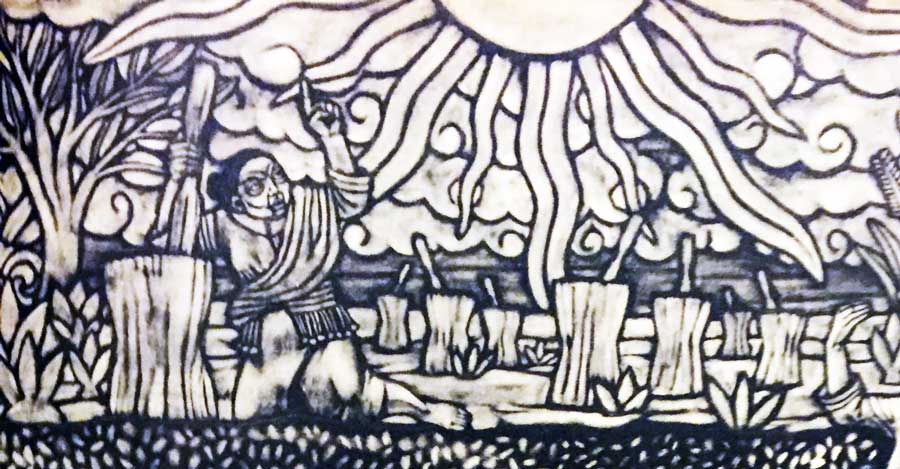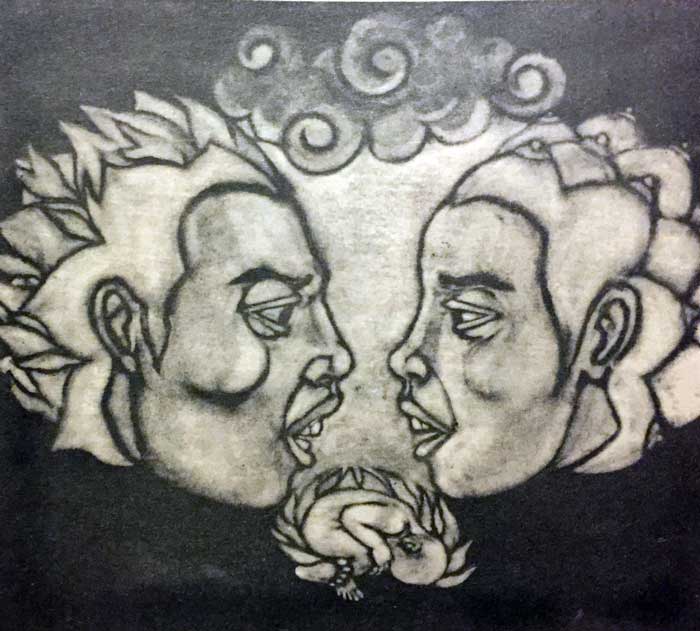“The interior of Mindanao is occupied by some ten tribes, the most ‘important’ being the Manóbos, Mandayas, Atás, Bagóbos, Biláns, Tirurais, and Subánuns. These tribes are all remarkably alike in culture; much more so, in fact, than any other similar group of peoples in the Philippines; and this culture shows a close resemblance to that of the tribes in the interior of Borneo. In the development of their myths and of their religious beliefs, these peoples occupy a middle position between the more primitive and the highest developed types of the Philippines.” – H. Otley Beyer
ORIGIN OF THE EARTH AND ITS INHABITANTS
The story of the creation of the world is variable throughout the whole Agúsan Valley. In the district surrounding Talakógon, the creation is attributed to Makalídung, the first great Manóbo. The details of his great work are very meagre. He set it up on posts (some say iron posts) with one in the center. At the central post he has his abode, in company with a python, according to the version of some, and whenever he feels displeasure toward men, he shakes the post, thereby producing an earthquake, and at the same time intimating to man his anger. It is believed that, should the trembling continue, the world would be destroyed.
In the same district it is believed that the sky is round and that its extremities are at the limits of the sea. Somewhat near these limits is an enormous hole called the navel of the sea through which the waters descend.
It is said that in the early days of creation the sky was low, but that one day a woman, while pounding rice, hit it with her pestle and it ascended to its present position.

Another version of the creation, prevalent among the Manóbos of the Argauan and Híbung Rivers, gives the control of the world to Dágau, who lives at the four fundamental pillars in the company of a python. Being a woman, Dágau dislikes the sight of human blood, and when it is spilled upon the face of the earth she incites the huge serpent to wreathe itself around the pillars and shake the world to its foundations. Should she become exceedingly angry, she diminishes the supply of rice either by removing it from the granary or by making the soil unproductive.
Another variation of the story to be heard on the Upper Agúsan, Simulau, and Umayan Rivers, has it that the world is like a huge mushroom and that it is supported upon an iron pillar in the center. This pillar is controlled by the higher and more powerful order of diuwáta, who on becoming angered at the actions of men manifest their feelings by shaking the pillar and thereby reminding men of their duties.
THE ORIGIN OF THE STARS AND THE EXPLANATION OF SUNSET AND SUNRISE
The sun, moon, and stars are great deities, or the dwelling place of such deities, in nearly all Philippine religions. The following Manóbo myth is interesting because of its resemblance to others from northern Luzon.
It is said that in the olden time the Sun and the Moon were married. They led a peaceful, harmonious life. Two children were the issue of their wedlock.
One day the Moon had to attend to one of the household duties that fall to the lot of a woman, some say to get water, others say to get the daily supply of food from the fields. Before departing, she crooned the children to sleep and told her husband to watch them but not to approach lest by the heat that radiated from his body he might harm them. She then started upon her errand.
The Sun, who never before had been allowed to touch his bairns, arose and approached their sleeping place. He gazed upon them fondly, and, bending down, kissed them, but the intense heat that issued from his countenance melted them like wax. Upon perceiving this he wept and quietly betook himself to the adjoining forest in great fear of his wife.
The Moon returned duly, and after depositing her burden in the house turned to where the children slept but found only their dried, inanimate forms. She broke out into a loud wail, and in the wildness of her grief called upon her husband. But he gave no answer.

Finally softened by the loud long plaints, he returned to his house. At the sight of him the wild cries of grief and of despair and of rebuke redoubled themselves until finally the husband, unable to soothe the wife, became angry and called her his chattel.
At first she feared his anger and quieted her sobs, but, finally breaking out into one long wail, she seized the burnt forms of her babes, and in the depth of her anguish and her rage threw them to the ground in different directions.
Then the husband became angry again, and, seizing some taro leaves that his wife had brought from the fields, cast them in her face and went his way. Upon his return he could not find his wife, and so it is to this day that the Sun follows the Moon in an eternal cycle of night and day. And so it is, too, that stars stand scattered in the sable firmament, for they, too, accompany her in her hasty flight.
Ever and anon a shooting star breaks across her path, but that is only a messenger from her husband to call her back. She, however, heeds it not, but speeds on her way in never-ending flight with the marks of the taro leaves still upon her face and her starry train accompanying her to the dawn and on to the sunset in one eternal flight.
Source: ORIGIN MYTHS AMONG THE MOUNTAIN PEOPLES OF THE PHILIPPINES By H. Otley Beyer (From the Division of Ethnology, Bureau of Science, Manila, P. I.)
ALSO READ:
VISAYAN Origin Myth: Creation of the Sun and Moon
NEGRITO Origin Myth: Creation of the World
IGOROT Origin Myths: The Creation
IFUGAO Origin Myth: The First Man & Woman
BICOL Origin Myth: The Creation of the World
The TAGALOGS Origin Myths: Bathala the Creator
Jordan Clark is a Canadian born descendant of Scottish immigrants living on the homelands of the Lekwungen speaking peoples. His interest in Philippine myth and folklore began in 2004. Finding it difficult to track down resources on the topic, he founded The Aswang Project in 2006. Shortly after, he embarked on a 5 year journey, along with producing partner Cheryl Anne del Rosario, to make the 2011 feature length documentary THE ASWANG PHENOMENON – an exploration of the aswang myth and its effects on Philippine society. In 2015 he directed “The Creatures of Philippine Mythology” web-series, which features 3 folkloric beings from the Philippines – the TIKBALANG, KAPRE and BAKUNAWA. Episodes are available to watch on YouTube. Jordan recently oversaw the editing for the English language release of Ferdinand Blumentritt’s DICCIONARIO MITOLÓGICO DE FILIPINAS (Dictionary of Philippine Mythology) and is working on two more releases with fellow creators scheduled for release later this year. When his nose isn’t in a book, he spends time with his amazing Filipina wife of 20 years and their smart and wonderful teenaged daughter.


